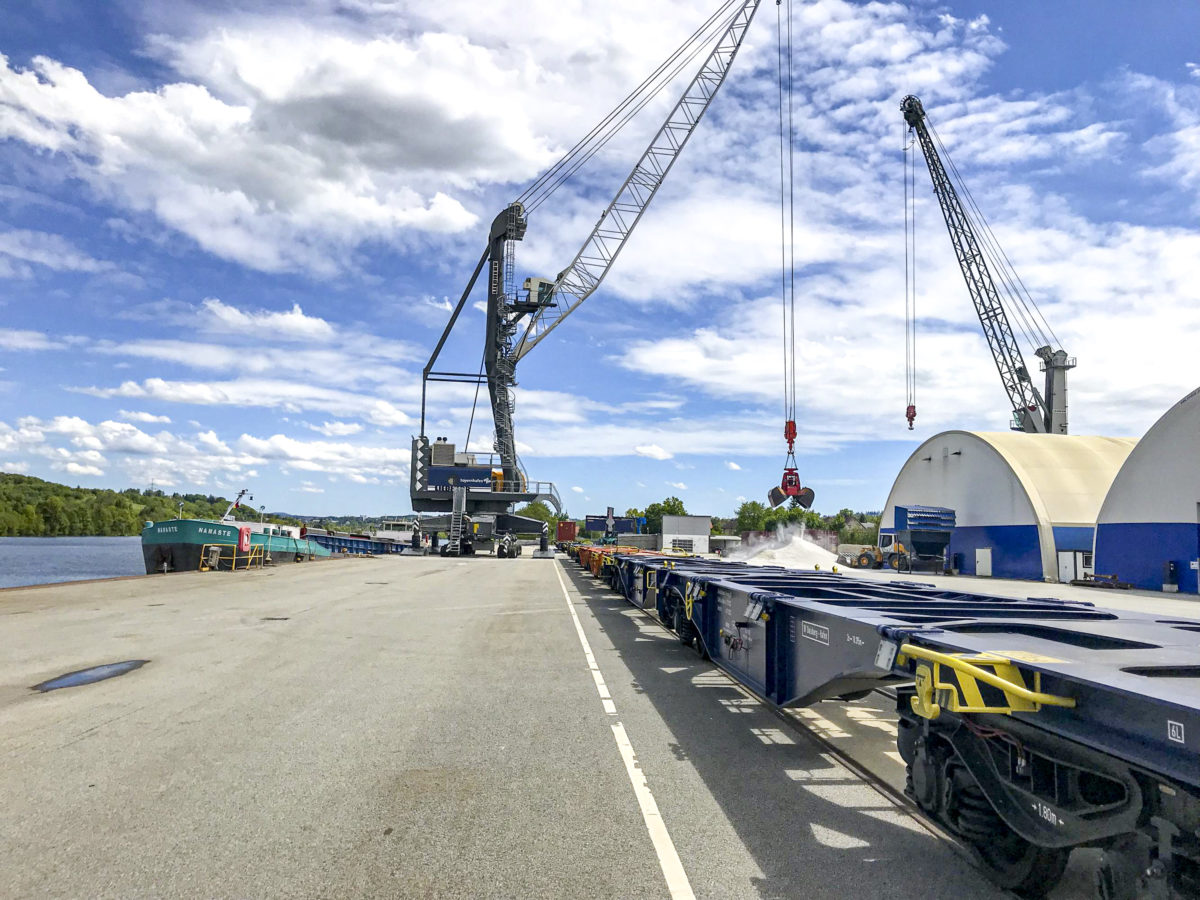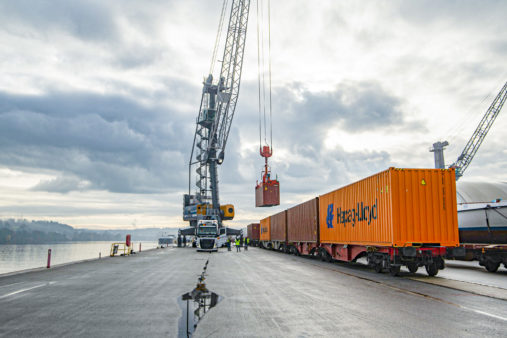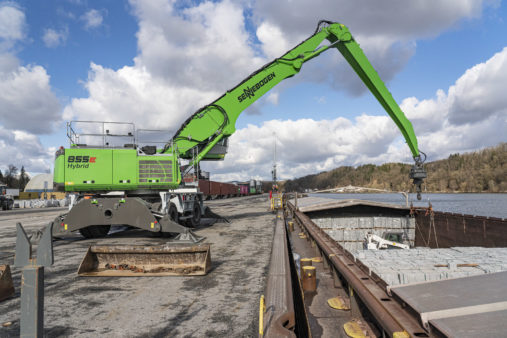29 March 2022 | Passau
bayernhafen Passau 2021: container throughput tops lighterage
2021 financial year: 308,657 tonnes of goods moved by inland waterway and rail; successful start of rail container services; bayernhafen invests around €4.3 million

The lion’s share of the shipping tonnage was made up of agricultural products, followed by construction materials, minerals and ores. (Image attribution: bayernhafen / Verena Riehl)
Regensburg, 28 March 2022 – bayernhafen brings together a diverse range of goods and delivers the right infrastructure to meet the challenge of shifting long-distance traffic from the road networks to the two environmentally friendly transport modes of inland waterway and rail. In 2021, bayernhafen moved a total of 9.15 million tonnes of cargo and freight by inland waterway and rail at its six locations of Aschaffenburg, Bamberg, Nuremberg, Roth, Regensburg and Passau – a 4.6% increase on the previous year. 308,657 tonnes of goods were moved by inland waterway and rail in Passau in 2021.
Our inland ports and the infrastructure they provide ensure the reliable supply of goods to the region as well as the shift to the more environmentally friendly transport modes of inland waterway and rail.
Joachim Zimmernann,
Chief Executive Officer of bayernhafen
Rail handling in Passau in 2021 climbed to 103,116 tonnes, more than double the volume of the previous year (+144.1%). This was primarily the result of the newly established Combined Transport link. In February 2021, a rail container service linking bayernhafen Passau to Hamburg, Bremerhaven, Bremen and Wilhelmshaven went into operations, mainly transporting containers loaded with automotive components and commercial goods from the north to Lower Bavaria. In the other direction, goods are exported from across different sectors of the Lower Bavarian economy, including automotive, the regenerative systems technology sector and agriculture. Almost 3,000 TEU (twenty foot equivalent unit) were loaded onto barge at Passau in 2021. Other important rail cargo and freight in Passau are cement and motor vehicles.
In 2021, 205,541 tonnes of goods were moved by inland waterway at Passau, 49.3% less than in the previous year. This was principally due to the fact that the good water levels meant that there was very little need for lightering services for inter-regional ship transport. bayernhafen Passau is the last port on the Danube for ships coming from Southeast Europe before the undeveloped section between Vilshofen and Straubing. This stretch of the Danube requires cargo ships to perform “lighterage”, that is adjust their draft accordingly through offloading a part of their cargo on to another ship or storing it temporarily on land. In 2021, ships were able to transit largely without the need for lighterage, leading to a statistical decrease on the previous year. This is, however, not reflected in the local economy. The lion’s share of the shipping tonnage was made up of agricultural products, followed by construction materials, minerals and ores. Heavy-lift/large-volume transport also continued to play a major role at the Passau-Schalding location. The same was true of ro-ro transport, which links Passau via Enns to Vidin and Ruse in Bulgaria.
“At each of the regions in which we operate we act as a hub for the import and export of goods and are a driver of the regional economy. Our inland ports and the infrastructure they provide ensure the reliable supply of goods to the region as well as the shift to the more environmentally friendly transport modes of inland waterway and rail,” says Joachim Zimmermann, the Chief Executive Officer of bayernhafen. “This requires investment in trimodal port infrastructure and the concentration of logistics companies at the ports. That is why we must emphatically reject the idea of restricting functioning port land through changes of use in the surrounding areas, or using port land for other purposes on a larger scale. In the spirit of mutual consideration, any existing restrictions need to be minimized.”
It is currently not possible for bayernhafen to estimate the extent of the impact the war in Ukraine will have on the economy and hence on the logistics sector and international supply chains, whether on container traffic, agricultural produce or the supply of raw material for industry.
When we invest in new vehicles and machines, we always strive to source them on the basis of the latest powertrain technologies, the best emissions standards, and the highest energy efficiency.
Stefan Ring,
Head of Technology and Operations at bayernhafen Passau
bayernhafen investment in Passau remains at high level
In 2021, bayernhafen initiated a € 4.3 million investment programme at the Passau location in the redevelopment and maintenance of its port infrastructure. One of its projects involved further expansion of its river cruise infrastructure in Racklau. At the end of the year, new drinking water supply points for hotel ships went into operation. In addition, bayernhafen plans to acquire shore-power facilities with six charging points for river cruise ships. While they are at berth, they will be able to switch off their diesel generators, resulting in a reduction in CO2 and particulate emissions. bayernhafen will bear the investment costs, with total financial aid from the Free State of Bavaria and from the federal government amounting to € 1 million. Over the longer term, it is planned to construct a cruise ship terminal in Passau-Racklau.
To optimise the handling of bulky and general cargo, a new Sennebogen 855 E Hybrid mobile material handler was acquired. “When we invest in new vehicles and machines, we always strive to source them on the basis of the latest powertrain technologies, the best emissions standards, and the highest energy efficiency,” says Stefan Ring, Head of Technology and Operations at bayernhafen Passau.
Through targeted investments, we are developing and creating a future-proof service for both sustainable freight transport and the river cruise sector.
Andrea Betz,
Head of Real Estate Business at bayernhafen Passau
In 2022, bayernhafen Passau is planning to launch an investment programme of over € 2 million that will involve, for example, building a new operations building.
“A lot has been done in recent years at bayernhafen Passau. Through targeted investments, we are developing and creating a future-proof service for both sustainable freight transport and the river cruise sector. This makes us a strong partner for our customers,” says Andrea Betz, Head of Real Estate Business at bayernhafen Passau.
River cruise sector
There was a partial recovery in the river cruise sector in 2021. In 2021, 250 river cruise ships called in at bayernhafen Passau, 81.2% more than in 2020.
Implementation of nature protection and biodiversity measures
bayernhafen maintains an eco-account for further construction developments. This account enables bayernhafen to implement the requisite biodiversity offsetting measures in advance and maintain a reserve for future use. Following the completion of the planning and preparation for the creation of eco-account sites at the Passau-Schalding site in 2021, the measures are to be implemented in the course of this year. The biodiversity protection goal involves expanding the existing soft-wood copses and developing hardwood coppices. In future planning permission procedures, eco-points can be used to offset construction measures. This will enable bayernhafen as a site architect to combine the development and management of tailored industrial sites, commercial areas and transport facilities with natural areas.


